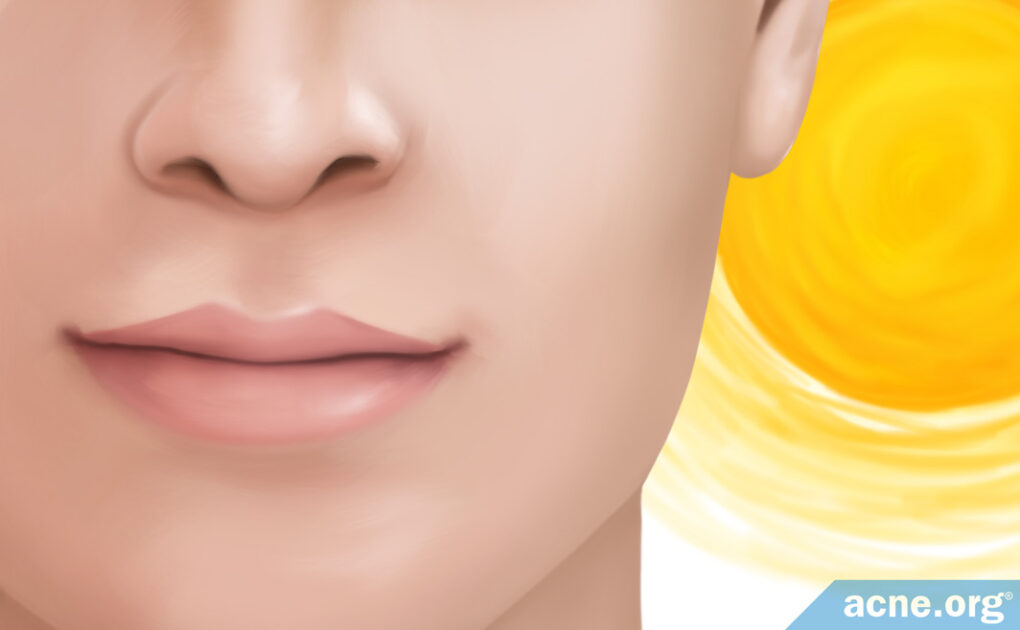The Lips Burn, but Rarely Tan. Sun Protection Is Important.

The Essential Info
The lips make up part of the skin, and just like bodily skin, the lips are impacted by sun damage.
However, compared to the body, the lips contain drastically lower amounts of skin pigment (melanin), so the lips rarely, if ever, tan. However, the lips can still burn.
Lip Balm with SPF: Lip balms that contain sunscreen ingredients can help reduce sun damage to the lips. If you’re going to be out in the sun and need protection:
- Choose a lip balm that has an SPF of 15 or greater. I like an SPF of 15 because that means the manufacturer included less potentially pore-clogging ingredients compared to a sunscreen with a higher SPF number.
- Choose a lip balm that specifically states that it is “broad-spectrum.”
- Double check lip balm ingredients against the potentially pore-clogging ingredients list.
- Reapply every 2 hours when your lips are exposed to the sun.
- Pay attention to the skin around your lips. If you start breaking out around your mouth after you start using a new lip balm, switch brands. This is a real problem. I have experienced it myself when trying new lip balms. Be tough on your lip balm! Don’t let it keep you in a cycle of acne.

The Science
The skin on the lips, just like the skin on the rest of the body, serves as a protective barrier to the tissues underneath. However, the skin on the lips has some major differences that make the lips:
- More prone to sunburn
- Less prone to suntan
- More prone to dryness
Little to No Melanin – More prone to sunburn, Less prone to suntan
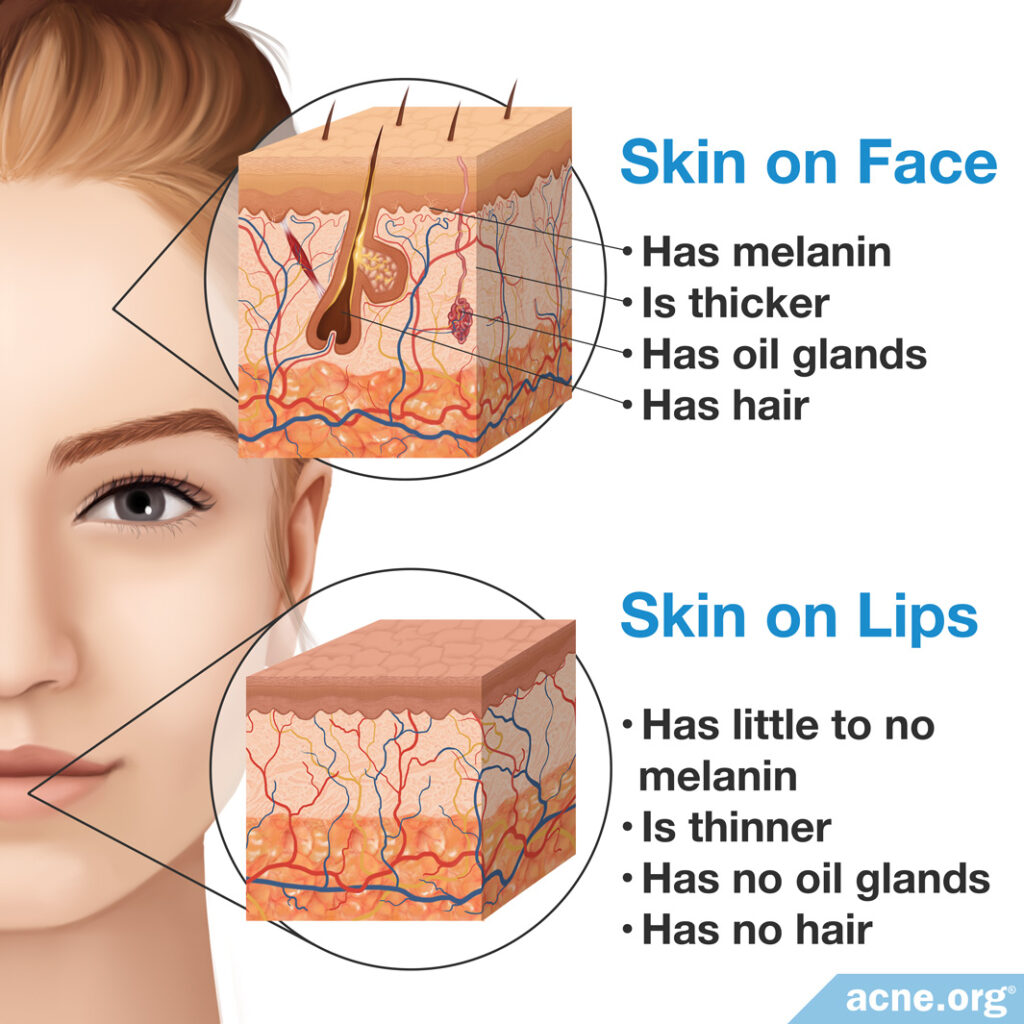
Melanin is a pigment in the skin that gives skin its color and protects the skin from the sun – the more melanin, the greater skin protection.
The lips, however, contain little, if any, melanin. The lips’ reddish color instead comes from blood vessels in the dermis, rather than from melanin.
The lips’ lack of melanin means they do not tan.
However, since melanin protects the skin from the sun, the lack of melanin in the lips means they are less protected from the sun and thus more prone to sunburn.1-3
Thinner Skin with No Oil Glands – More prone to dryness
The skin of the lips is one of the thinnest-skinned areas of the entire body.
All of the layers of skin on the lips are thin, including the topmost layer of the skin, called the stratum corneum. The stratum corneum is the part of the skin that helps prevent water loss, so a thinner stratum corneum means the lips lose water more easily than other areas of the skin.
To make matters worse, the lips contain no skin oil glands, which help lubricate and moisturize the skin on the rest of the body.
For these reasons, the skin of the lips is more susceptible to the drying effects of sun exposure.
Expand to read how sun damage affects the skin, including the skin on the lips
There are three types of radiation generated by the sun that reach the Earth’s surface.
- Ultraviolet (UV)
- Infrared (IR)
- Visible light4
Of these, UV radiation is the type that burns or tans the skin. UV radiation itself is broken down into three categories, according to their wavelengths.
- UVA radiation: Primarily responsible for skin tanning
- UVB radiation: Primarily responsible for skin burning
- UVC radiation: Unable to penetrate the ozone layer and thus does not reach the Earth’s surface5
As shown in the chart below, each type of UV radiation possesses a different wavelength, which limits how far into the skin they can penetrate. UVA radiation has the longest wavelength and UVC, the shortest. Since UVA rays are longer in wavelength, they are able to penetrate deeper into the skin than UVB rays, activating melanin production and tanning the skin. UVB rays do not reach as far down and are almost entirely absorbed by the epidermis. Because UVB rays do not penetrate the skin where melanin is produced, they do not affect tanning as much as UVA rays and are responsible mainly for burning the top of the skin.5,6
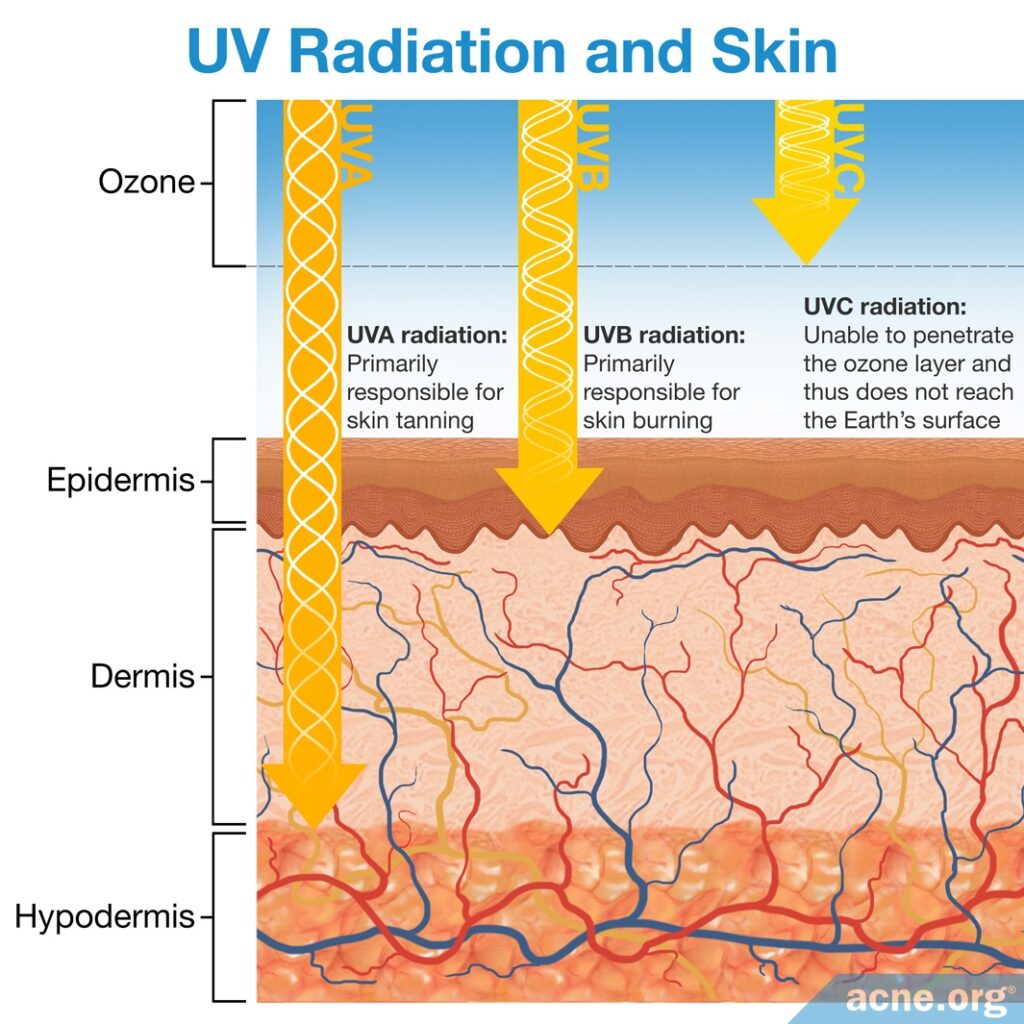
Sunburn vs. Suntan of the Lips
Sunburn – The Lips Do Burn
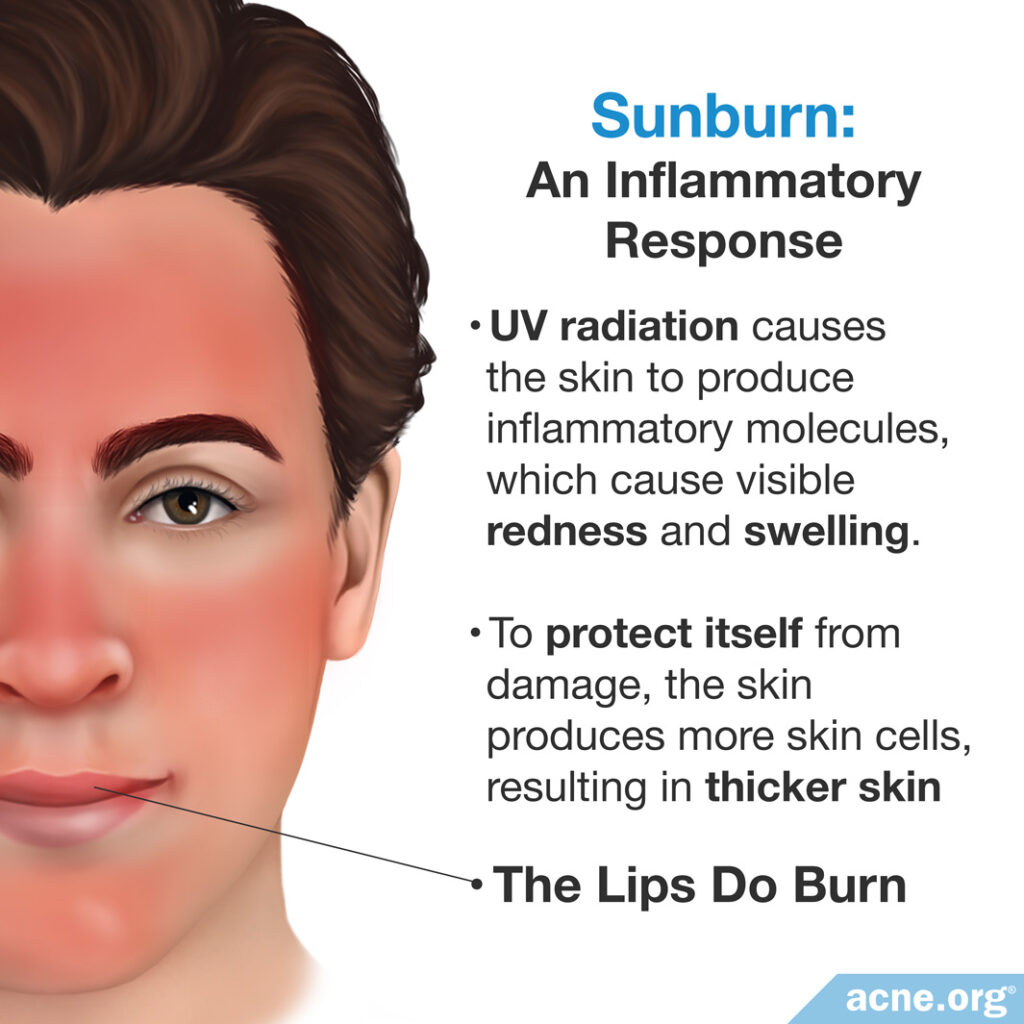
Sunburn is an acute inflammatory response of the skin after exposure primarily to the sun’s UVB rays and can manifest on any area of the skin, including the lips.
UV rays cause the skin to produce inflammatory molecules, which cause visible redness and swelling. In an attempt to protect itself from damage, skin cells may also begin to divide into more cells, resulting in thickening of the skin within a few hours of sunburn.5
Suntan – The Lips Do Not Tan
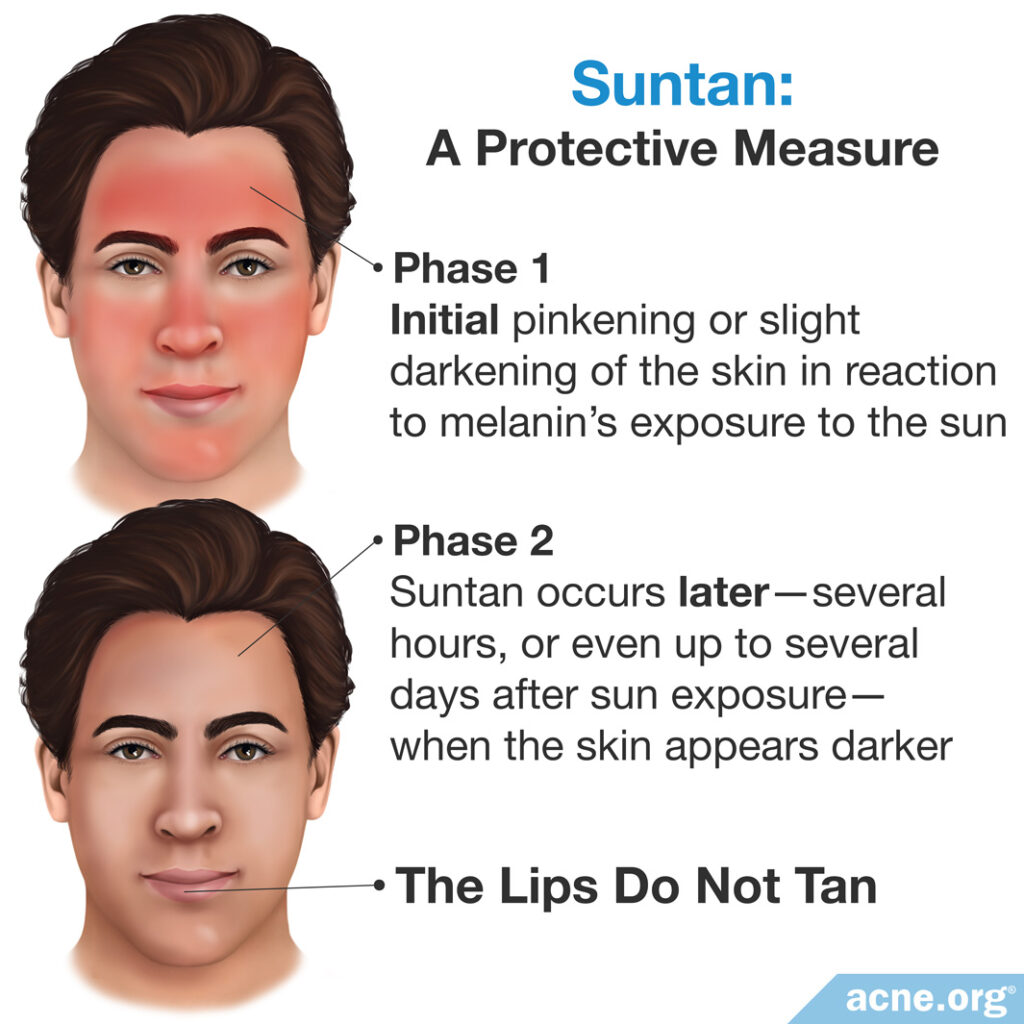
Suntan is a protective measure taken by the skin in response to sun exposure. However, suntan is regulated by melanin. The lips contain little to no melanin, so they do not tan.
Suntan happens in two phases:
- Phase 1 is the initial pinkening or slight darkening of the skin in reaction to melanin’s exposure to the sun. This is the result of changes to the existing melanin in the skin.
- Phase 2 of suntan occurs later – several hours, or even up to several days, after sun exposure – when the skin appears darker. This results from the skin producing more melanin and is what typically is referred to as “suntan.”5
Because they contain very little or no melanin, the process of sun tanning rarely occurs in the lips, making sunburn their primary type of reaction to sun exposure.
Given the lips’ propensity toward burning, it is important to determine how to protect the lips from sun damage. This is particularly important if you are out in the sun a lot, because chronic exposure of the lips to the sun’s rays may result in a potentially dangerous condition called actinic cheilitis.
Actinic Cheilitis: A Lip Condition That Can Develop after Long-term Sun Exposure
Actinic cheilitis is inflammation of the lips that can occur due to long-term sun exposure. A person with actinic cheilitis has severely chapped, scaly lips. This condition is also called Sailor’s Lip because it usually affects outdoor laborers such as sailors, farmers, construction workers, and lifeguards. While actinic cheilitis may be painless, it is potentially dangerous since it may develop into a type of skin cancer called squamous cell carcinoma.
Actinic cheilitis happens more frequently on the lower lip, since more light from the sun hits the lower lip compared to the upper lip. Also, it is more prevalent among fair-skinned people and affects men more than women, perhaps because men are more likely to work outside without wearing lip balm containing sunscreen.7
A preliminary study from 2019 found that regular use of sunscreen-containing lip balms can prevent the development or reduce the symptoms of actinic cheilitis.8 We need more evidence to back this up, but one thing is certain—our lips need protection from the sun, so make sure to use SPF-containing lip balms in your everyday routine.
How to Protect Lips from The Sun’s Rays
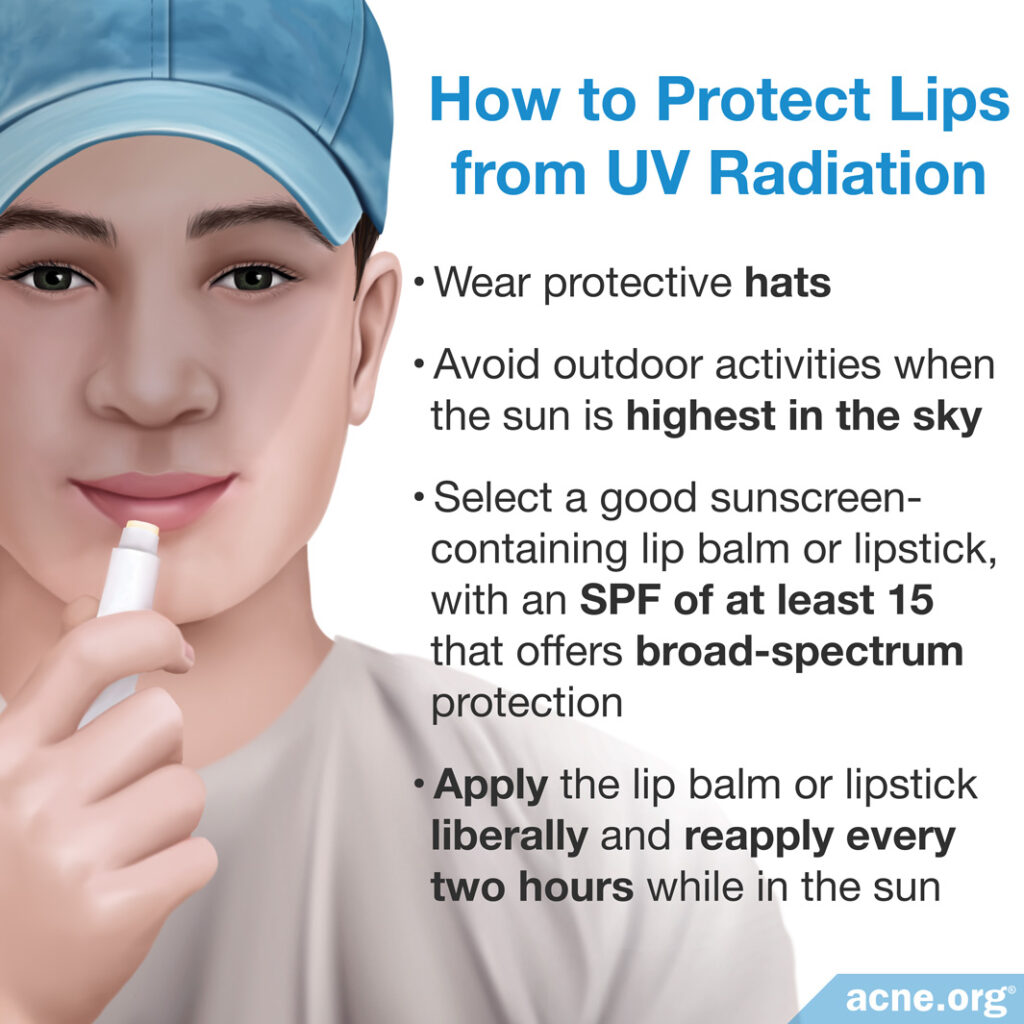
Since sun damage to the lips is similar to sun damage to other areas of the skin, similar measures must be taken to protect the lips as are taken to protect the skin in general. Proper sun protection and limiting sun exposure can significantly lower the incidence of sunburn on the lips. Steps that you can take are:
- Wearing protective hats
- Avoiding outdoor activities when the sun is “highest” in the sky
- Selecting a good sunscreen-containing lip balm or lipstick, with an SPF of at least 15 and that offers broad-spectrum protection
- Applying the lip balm or lipstick liberally and reapplying every two hours while in the sun9-13
The Bottom Line
Due to their lack of melanin, the lips are more prone to burn than the rest of the skin, and they rarely tan. Taking proper precautions, such as limiting sun exposure and applying sunscreen, can drastically reduce this risk and is worth making a part of your daily skincare routine.
References
- Vent, J., Lefarth, F., Massing, T. & Angerstein, W. Do you know where your fillers go? An ultrastructural investigation of the lips. Clin. Cosmet. Investig. Dermatol. 7, 191 – 9 (2014). https://www.ncbi.nlm.nih.gov/pubmed/25018646
- Arda, O., Göksügür, N. & Tüzün, Y. Basic histological structure and functions of facial skin. Clin. Dermatol. 32, 3 – 13 (2014). https://www.ncbi.nlm.nih.gov/pubmed/24314373
- Tamura, E., Ishikawa, J., Naoe, A. & Yamamoto, T. The roughness of lip skin is related to the ceramide profile in the stratum corneum. Int. J. Cosmet. Sci. 38, 615 – 621 (2016). https://www.ncbi.nlm.nih.gov/pubmed/27090066
- Sklar, L. R., Almutawa, F., Lim, H. W. & Hamzavi, I. Effects of ultraviolet radiation, visible light, and infrared radiation on erythema and pigmentation: a review. Photochem. Photobiol. Sci. 12, 54 – 64 (2013). https://www.ncbi.nlm.nih.gov/pubmed/23111621
- D’Orazio, J., Jarrett, S., Amaro-Ortiz, A. & Scott, T. UV Radiation and the Skin. Int. J. Mol. Sci. 14, 12222 – 48 (2013). https://www.ncbi.nlm.nih.gov/pubmed/23749111
- Cichorek, M., Wachulska, M., Stasiewicz, A. & Tymińska, A. Skin melanocytes: biology and development. Postepy Dermatol. Alergol. 30, 30 – 41 (2013). https://www.ncbi.nlm.nih.gov/pubmed/24278043
- Muse, M. E. & Crane, J. S. Actinic Cheilitis. In: StatPearls [Internet]. Treasure Island (FL): StatPearls Publishing; 2020 Jan-. Available from: https://www.ncbi.nlm.nih.gov/books/NBK551553/
- Rodriguez-Blanco, I., et al. Use of lip photoprotection in patients suffering from actinic cheilitis. European Journal of Dermatology: EJD 29, 383-386 (2019). https://pubmed.ncbi.nlm.nih.gov/31475909/
- Wood, N. H., Khammissa, R., Meyerov, R., Lemmer, J. & Feller, L. Actinic cheilitis: a case report and a review of the literature. Eur. J. Dent. 5, 101 – 6 (2011). https://www.ncbi.nlm.nih.gov/pmc/articles/PMC3019754/
- Jadotte, Y. T. & Schwartz, R. A. Solar cheilosis: an ominous precursor: part I. Diagnostic insights. J. Am. Acad. Dermatol. 66, 173 – 84; quiz 185 – 6 (2012). https://www.ncbi.nlm.nih.gov/pubmed/22243721
- Maier, H., Schauberger, G., Brunnhofer, K. & Hönigsmann, H. Assessment of thickness of photoprotective lipsticks and frequency of reapplication: results from a laboratory test and a field experiment. Br. J. Dermatol. 148, 763 – 9 (2003). https://www.ncbi.nlm.nih.gov/pubmed/12752136
- Busick, T. L., Uchida, T. & Wagner, R. F. Jr. Preventing ultraviolet light lip injury: beachgoer awareness about lip cancer risk factors and lip protection behavior. Dermatol. Surg. 31, 173 – 6 (2005). https://www.ncbi.nlm.nih.gov/pubmed/15762210
- López-Jornet, P., Camacho-Alonso, F. & Rodríguez-Espin, A. Study of lip hydration with application of photoprotective lipstick: influence of skin phototype, size of lips, age, sex and smoking habits. Med. Oral Patol. Oral Cir. Bucal. 15, e445 – 50 (2010). https://www.ncbi.nlm.nih.gov/pubmed/20038895
 Acne.org Products
Acne.org Products